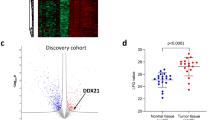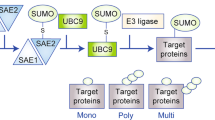Abstract
The DEAD box RNA helicase, p68, is upregulated in exponentially growing cells and shows cell cycle-dependent changes in nuclear localization. Although some other DEAD box proteins have been implicated in cancer, there have been no reports of any link between p68 status and carcinogenesis. In the present study we have analysed specimens from 50 patients with colorectal adenocarcinomas, including cases in which an adenomatous polyp was also present, by immunohistochemistry and Western blotting. Our data indicate that p68 protein is consistently overexpressed in tumours as compared with matched normal tissue. Examination of the levels of p68 mRNA from both normal and tumour tissue showed no obvious specific increase in p68 mRNA levels in tumours nor any evidence of underlying mutations in the p68 coding region. Interestingly, however, the accumulated p68 appears to be poly-ubiquitylated, suggesting a possible defect in proteasome-mediated degradation in these tumours. This overexpression/ubiquitylation is observed in both pre-invasive and invasive lesions suggesting that the dysregulation of p68 expression occurs early during tumour development. Finally, we demonstrate that ubiquitylation of p68 occurs in cultured cells, thereby providing a model for the molecular analysis of this process and its potential role in tumorigenesis.
This is a preview of subscription content, access via your institution
Access options
Subscribe to this journal
Receive 50 print issues and online access
$259.00 per year
only $5.18 per issue
Buy this article
- Purchase on Springer Link
- Instant access to full article PDF
Prices may be subject to local taxes which are calculated during checkout








Similar content being viewed by others
References
Akao Y, Marukawa O, Morikawa H, Nakao K, Kamei M, Hachiya T, Tsujimoto Y . 1995 Cancer Res. 55: 3444–3449
Ciechanover A . 1998 EMBO J. 17: 7151–7160
Ciechanover A, Orian A, Schwartz AL . 2000 Bioessays 22: 442–451
Cummings CJ, Mancini MA, Antalffy B, DeFranco DB, Orr HT, Zoghbi HY . 1998 Nat. Genet. 19: 148–154
Davies SW, Turmaine M, Cozens BA, DiFiglia M, Sharp AH, Ross CA, Scherzinger E, Wanker EE, Mangiarini L, Bates GP . 1997 Cell 90: 537–548
Desterro JM, Rodriguez MS, Hay RT . 2000 Cell. Mol. Life Sci. 57: 1207–1219
Evan GI, Lewis GK, Ramsay G, Bishop JM . 1985 Mol. Cell. Biol. 5: 3610–3616
Fearon ER, Vogelstein B . 1990 Cell 61: 759–767
Ford MJ, Anton IA, Lane DP . 1988 Nature 332: 736–738
Fuller-Pace FV . 1994 Trends Cell. Biol. 4: 271–274
Gavioli R, Frisan T, Vertuani S, Bornkamm GW, Masucci MG . 2001 Nature Cell Biol. 3: 283–288
George RE, Kenyon RM, McGuckin AG, Malcolm AJ, Pearson AD, Lunec J . 1996 Oncogene 12: 1583–1587
Godbout R, Squire J . 1993 Proc. Natl. Acad. Sci. USA 90: 7578–7582
Gregory MA, Hann SR . 2000 Mol. Cell. Biol. 20: 2423–2435
Harlow E, Lane D . 1988 Antibodies: A laboratory Manual Cold Spring Harbor Laboratory, New York
Hirling H, Scheffner M, Restle T, Stahl H . 1989 Nature 339: 562–564
Hochstrasser M . 1996 Cell 84: 813–815
Iggo RD, Jamieson DJ, MacNeill SA, Southgate J, McPheat J, Lane DP . 1991 Mol. Cell. Biol. 11: 1326–1333
Iggo RD, Lane DP . 1989 EMBO J. 8: 1827–1831
Kopito RR, Sitia R . 2000 EMBO Rep. 1: 225–231
Lane DP, Hoeffler WK . 1980 Nature 288: 167–170
Mahajan R, Delphin C, Guan T, Gerace L, Melchior F . 1997 Cell 88: 97–107
Matunis MJ, Wu J, Blobel G . 1998 J. Cell. Biol. 140: 499–509
Muller S, Matunis MJ, Dejean A . 1998 EMBO J. 17: 61–70
Nakagawa Y, Morikawa H, Hirata I, Shiozaki M, Matsumoto A, Maemura K, Nishikawa T, Niki M, Tanigawa N, Ikegami M, Katsu K, Akao Y . 1999 Br. J. Cancer 80: 914–917
Nicol SM, Causevic M, Prescott AR, Fuller-Pace FV . 2000 Exp. Cell. Res. 257: 272–280
Rodriguez MS, Desterro JM, Lain S, Midgley CA, Lane DP, Hay RT . 1999 EMBO J. 18: 6455–6461
Scheffner M, Huibregtse JM, Vierstra RD, Howley PM . 1993 Cell 75: 495–505
Spence J, Gali RR, Dittmar G, Sherman F, Karin M, Finley D . 2000 Cell 102: 67–76
Squire JA, Thorner PS, Weitzman S, Maggi JD, Dirks P, Doyle J, Hale M, Godbout R . 1995 Oncogene 10: 1417–1422
Stevenson RJ, Hamilton SJ, MacCallum DE, Hall PA, Fuller-Pace FV . 1998 J. Pathol. 184: 351–359
Treier M, Staszewski LM, Bohmann D . 1994 Cell 78: 787–798
Webster GA, Perkins ND . 1999 Mol. Cell. Biol. 19: 3485–3495
Acknowledgements
We thank Liz Furrie, Ron Hay and David Lane for helpful discussions, George Thomson, Andy Grant and Jim Gibbs for advice on immunohistochemistry/imaging and our colleagues in the GI Laboratory for making available the tissues used in this study. This work was funded by grants from the Medical Research Council (UK), the Association for International Cancer Research and the Chief Scientist's Office of the Scottish Executive Health Department. F Fuller-Pace is a Medical Research Council Senior Fellow.
Author information
Authors and Affiliations
Corresponding author
Rights and permissions
About this article
Cite this article
Causevic, M., Hislop, R., Kernohan, N. et al. Overexpression and poly-ubiquitylation of the DEAD-box RNA helicase p68 in colorectal tumours. Oncogene 20, 7734–7743 (2001). https://doi.org/10.1038/sj.onc.1204976
Received:
Revised:
Accepted:
Published:
Issue Date:
DOI: https://doi.org/10.1038/sj.onc.1204976
Keywords
This article is cited by
-
The DEAD-box protein family of RNA helicases: sentinels for a myriad of cellular functions with emerging roles in tumorigenesis
International Journal of Clinical Oncology (2021)
-
The lncRNA NEAT1 activates Wnt/β-catenin signaling and promotes colorectal cancer progression via interacting with DDX5
Journal of Hematology & Oncology (2018)
-
Nucleic acid sensing pattern recognition receptors in the development of colorectal cancer and colitis
Cellular and Molecular Life Sciences (2017)
-
Overexpression of DHX32 contributes to the growth and metastasis of colorectal cancer
Scientific Reports (2015)
-
The DEAD box protein p68: a crucial regulator of AKT/FOXO3a signaling axis in oncogenesis
Oncogene (2015)



